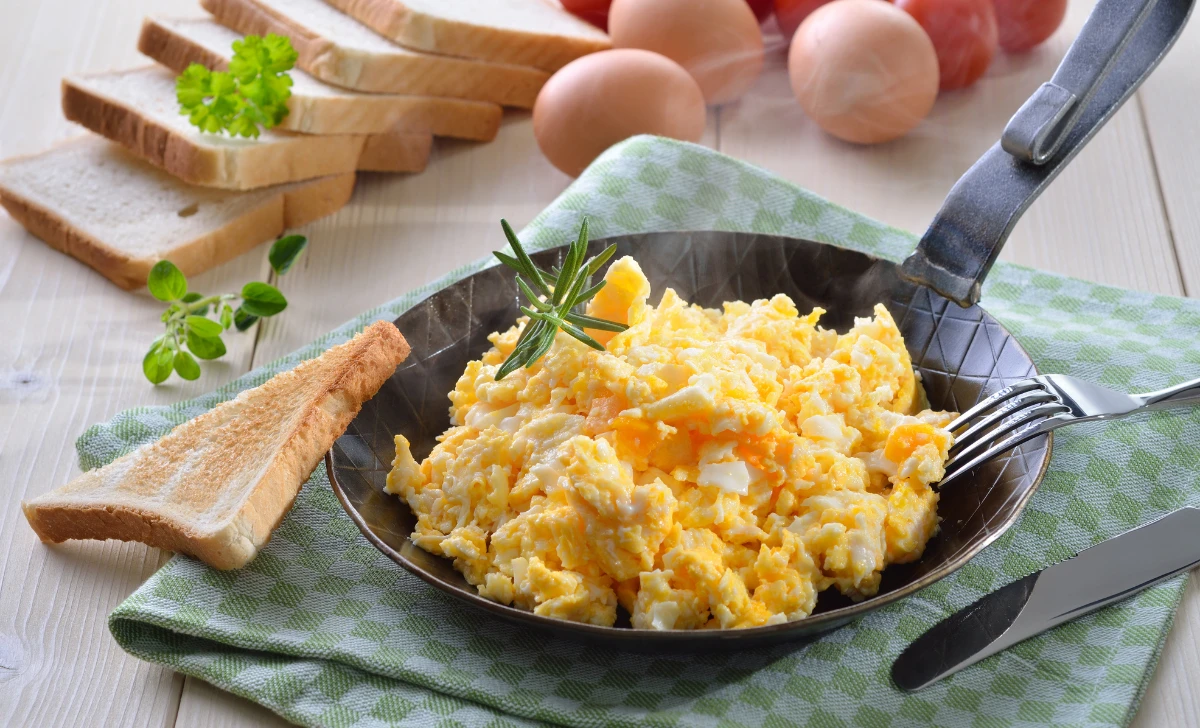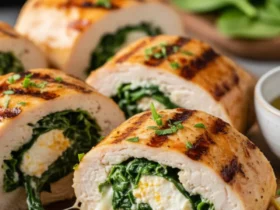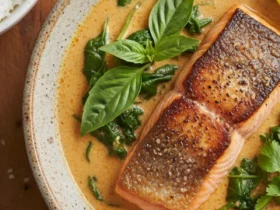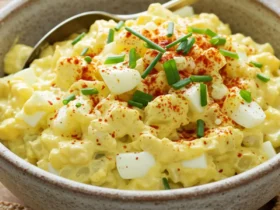If you’re on the lookout for a breakfast dish that’s quick, easy, and oh-so-satisfying, then look no further! Scrambled eggs are a classic morning staple that can be prepared in a jiffy and customized to your heart’s content. Whether you’re a culinary novice or a seasoned chef, these fluffy, creamy, and utterly delicious scrambled eggs are sure to tickle your taste buds. In this article, we’re going to take you through the steps of creating the perfect scrambled eggs that will leave you craving more.
[ez-toc]
History
Scrambled eggs – the simple yet delightful dish that has found its way onto breakfast tables across the world. The history of scrambled eggs is as rich and varied as the ways in which they can be prepared. Let’s take a journey back in time to uncover the origins and evolution of this beloved breakfast treat.
Early Beginnings
The concept of cooking eggs is as old as human civilization itself. Early humans likely discovered the joys of consuming eggs, whether gathered from wild birds or domesticated fowl. It’s believed that scrambled eggs, in their most rudimentary form, were created by beating eggs and cooking them over an open flame.
Ancient Influences
As civilizations developed, so did culinary techniques. Ancient Romans, for instance, enjoyed a dish called “minutal ova satura,” which involved beating eggs, adding various ingredients, and then cooking them. While not exactly the scrambled eggs we know today, this dish marked a step toward the creamy, curd-filled versions we now savor.
Medieval Europe and Beyond
The Middle Ages saw the emergence of more sophisticated cooking methods. European cooks began incorporating eggs into their recipes in various ways. By beating eggs and scrambling them in a pan, a more recognizable version of scrambled eggs began to take shape. While these preparations lacked the finesse of modern techniques, they paved the way for further experimentation.
Renaissance Refinement
The Renaissance period brought about a renewed interest in culinary arts and experimentation in the kitchen. Cookbooks from this era started featuring recipes that included eggs, often scrambled or cooked with other ingredients. However, the concept of the perfect scramble was still evolving, and it would take time to achieve the level of fluffiness and flavor we know today.
19th Century Innovations
As culinary techniques advanced, so did kitchen tools. The 19th century introduced better pans and utensils, allowing for more precise cooking. This era saw the refinement of scrambled egg recipes, with a greater emphasis on achieving a creamy texture and enhancing flavor with ingredients such as herbs and cheese.
20th Century Revolution
The 20th century witnessed a revolution in cooking, and scrambled eggs were no exception. The rise of convenience foods and kitchen appliances made it easier for home cooks to prepare a variety of dishes, including scrambled eggs. As global travel and cultural exchange increased, different regions added their own twists to the dish, incorporating local flavors and techniques.
Modern Mastery
Today, scrambled eggs have reached the pinnacle of culinary achievement. Chefs and home cooks alike have perfected the art of creating fluffy, creamy curds bursting with flavor. From the classic buttery version to innovative renditions with smoked salmon, truffle oil, and exotic spices, scrambled eggs have become a canvas for culinary creativity.
Time
| Step | Time |
|---|---|
| Gathering Your Ingredients | 5 minutes |
| Prepping Your Kitchen Battlefield | 3 minutes |
| Cracking and Whisking with Finesse | 2 minutes |
| Heating Up the Pan | 1 minute |
| The Low and Slow Approach | 5 minutes |
| Adding a Flavorful Twist | 1 minute |
| The Art of Curd Formation (Yes, Really!) | 4 minutes |
| The Cheesy Affair | 2 minutes |
| Incorporating Fresh Herbs and Veggies | 3 minutes |
| Timing Is Everything | 2 minutes |
| The Secret Ingredient | 1 minute |
| Plating Like a Pro | 1 minute |
| Amping Up Your Scramble Game | 3 minutes |
| Total | 33 minutes |
Please note that these timings are approximate and can vary based on your familiarity with the recipe and kitchen efficiency. Enjoy your delicious scrambled eggs!
Ingredients
| Ingredients | Quantity |
|---|---|
| Eggs | 4 |
| Butter or Olive Oil | 2 tablespoons |
| Salt and Pepper | To taste |
| Milk or Cream (optional) | 2 tablespoons |
| Grated Cheese (optional) | 1/4 cup |
| Fresh Herbs (optional) | 1 tablespoon |
| Veggies (optional) | 1/4 cup |
| Crème Fraîche or Cream Cheese (optional) | 1 tablespoon |
Adjust the quantities of ingredients based on your taste preferences and the number of servings you need. Enjoy your delicious scrambled eggs!
Directions
Step 1: Gathering Your Ingredients
Gather all your ingredients – eggs, butter or olive oil, salt, pepper, milk or cream (if using), grated cheese (if using), fresh herbs (if using), diced veggies (if using), and crème fraîche or cream cheese (if using).
Step 2: Prepping Your Kitchen Battlefield
Set up your cooking space with a mixing bowl, a whisk, a non-stick skillet, a spatula, and a warm plate. Having everything ready will make your cooking process seamless.
Step 3: Cracking and Whisking with Finesse
Crack the eggs into the mixing bowl and whisk them gently until the yolks and whites are well combined. This is your chance to give those biceps a mini workout!
Step 4: Heating Up the Pan
Place your non-stick skillet over medium-low heat and melt the butter or olive oil. Listen for that delightful sizzle – it’s a signal that you’re on the right track.
Step 5: The Low and Slow Approach
Pour the whisked eggs into the skillet and let them sit for a moment. Then, use your spatula to gently push the eggs from the edges towards the center. This slow and steady technique will reward you with the creamiest curds.
Step 6: Adding a Flavorful Twist
Sprinkle in a pinch of salt and a dash of pepper to season the eggs. These simple additions will transform your scramble from ordinary to extraordinary. Adjust the amount to suit your taste.
Step 7: The Art of Curd Formation (Yes, Really!)
As you continue to gently push the eggs around, you’ll witness those lovely curds forming. These curds are the heart of your scrambled eggs, creating a texture that’s both luscious and satisfying.
Step 8: The Cheesy Affair
If you’re a cheese lover, now’s the time to add that grated cheese. Watch it melt into the eggs, creating a velvety dance of flavors. This step is where the magic happens!
Step 9: Incorporating Fresh Herbs and Veggies
For an explosion of freshness and color, toss in finely chopped herbs or sautéed veggies. They’ll add an extra layer of flavor and visual appeal to your scramble.
Step 10: Timing Is Everything
Keep a watchful eye on your eggs as they cook. They should be soft and slightly runny. Remove the pan from the heat just before they’re fully set – residual heat will finish the cooking process.
Step 11: The Secret Ingredient
For an indulgent touch, add a dollop of crème fraîche or cream cheese. This hidden gem will infuse your scramble with unparalleled silkiness and richness.
Step 12: Plating Like a Pro
Transfer your dreamy scramble onto a warm plate. Sprinkle more herbs or a dash of paprika on top for an added burst of color and flavor. Remember, presentation matters!
Step 13: Amping Up Your Scramble Game
Congratulations, you’ve mastered the art of making the perfect scrambled eggs! Now, the sky’s the limit. Experiment with toppings like avocado, smoked salmon, or truffle oil. Let your creativity shine.
Enjoy your scrumptious scrambled eggs that are sure to brighten up your breakfast table!
Equipment Required
Nutrition Information
| Nutrient | Amount |
|---|---|
| Serving Size | 2 eggs |
| Calories | 160 |
| Total Fat | 12g |
| – Saturated Fat | 5g |
| Cholesterol | 370mg |
| Sodium | 340mg |
| Total Carbohydrates | 1g |
| – Dietary Fiber | 0g |
| – Sugars | 0g |
| Protein | 12g |
| Vitamin D | 23% DV |
| Calcium | 6% DV |
| Iron | 8% DV |
| Potassium | 110mg |
These values are approximate and can vary based on the specific ingredients used. Enjoy your nutritious and delicious scrambled eggs!
Tips
- Temperature Control: Cook your scrambled eggs over medium-low heat for the creamiest results. High heat can lead to overcooking and tough curds.
- Use a Non-Stick Pan: A non-stick skillet is your best friend when making scrambled eggs. It prevents sticking and makes cleanup a breeze.
- Butter vs. Oil: Butter adds flavor, while olive oil imparts a slightly different taste. Choose based on your preference – or even try a combination of both!
- Whisk Like You Mean It: Give your eggs a good whisking for uniform color and texture. It also introduces air for fluffiness.
- Season Early: Don’t forget to season your eggs while they’re in the bowl. This ensures even distribution of flavor.
- Low and Slow Wins the Race: Patience pays off. Cooking your eggs slowly allows for delicate curd formation and prevents them from becoming rubbery.
- Pre-Cook Veggies: If using veggies, sauté them briefly before adding the eggs. This prevents excess moisture from making your scramble watery.
- Grated Cheese is Key: Opt for grated cheese – it melts more evenly than larger chunks, resulting in a gooey, creamy texture.
Pros & Cons
| Pros | Cons |
|---|---|
| ✅ Quick & easy to make | ❌ High cholesterol content |
| ✅ Customizable with various ingredients | ❌ Potential for overcooking |
| ✅ Rich in protein and nutrients | ❌ Requires attention and technique |
| ✅ Versatile for breakfast or brunch | ❌ May cause allergies for some |
| ✅ Provides room for creativity | ❌ Can be high in saturated fat |
Conclusion
There you have it, the perfect scrambled eggs recipe that’s bound to make your taste buds dance with delight. From the moment you crack those eggs to the glorious unveiling of creamy curds, this recipe promises a breakfast experience that’s quick, easy, and incredibly satisfying.
Whether you’re a culinary adventurer seeking to add a flavorful twist or a breakfast enthusiast looking for a go-to morning treat, scrambled eggs are here to cater to your cravings. With just a few simple ingredients and a touch of creativity, you’ll be on your way to creating a breakfast masterpiece that’s uniquely yours.
Remember, each step of this journey is an opportunity to explore your culinary prowess. Tweak the ingredients, experiment with flavors, and make this recipe your own canvas. The low and slow technique, the incorporation of fresh herbs and veggies, and the touch of a secret ingredient – these are all part of your culinary toolkit that can turn an ordinary morning into an extraordinary experience.
So, whether you’re looking for a solo breakfast moment of indulgence or a delightful brunch to share with loved ones, this scrambled eggs recipe is your ticket to breakfast bliss. Let your creativity run wild, your taste buds rejoice, and your mornings be forever transformed.
What are you waiting for? Get cracking, whisking, and sizzling – your perfect plate of scrambled eggs awaits. Bon appétit! 🍳🔥🌱
Facts
- 🍳 Fact 1: Egg-citing Beginnings
- Did you know that scrambled eggs have been enjoyed since ancient times? Ancient Romans had their own version called “minutal ova satura,” involving beaten eggs and various ingredients cooked together. Imagine a glimpse into breakfast history while savoring your modern scramble!
- 🔥 Fact 2: Renaissance Egg-stravaganza
- During the Renaissance, culinary arts took center stage. Cookbooks featured scrambled egg recipes that were the talk of the town. Who knew that this breakfast staple had such a starring role in the culinary evolution of history?
- 🌶️ Fact 3: Spices and All Things Nice
- In the Middle Ages, spices were prized possessions. Spices like nutmeg and cinnamon were often added to scrambled eggs, creating a unique and unexpected flavor profile. It’s like they were the original “secret ingredient” enthusiasts!
- 🍴 Fact 4: Egg Wars and Culinary Innovation
- In 17th-century France, the “omelette war” erupted between King Louis XV and his chief of police. This dispute over egg prices led to the birth of the modern omelette as we know it today. Who knew scrambled eggs could be so revolutionary?
- 🌐 Fact 5: Global Egg-splosion
- Scrambled eggs are enjoyed worldwide, and each culture adds its own twist. From Indian “bhurji” with spices to Mexican “huevos revueltos” with salsa, eggs have become a canvas for global culinary creativity. Take your taste buds on a virtual world tour with your breakfast plate!
FAQ’s
Can I use milk instead of cream in my scrambled eggs?
Absolutely! Milk works perfectly as a creamy alternative to cream and adds a subtle richness to your eggs.
How can I prevent my scrambled eggs from becoming rubbery?
Cooking over medium-low heat and removing the eggs from the pan just before they’re fully set will help you achieve that perfect creamy texture.
Can I make scrambled eggs without butter or oil?
Definitely! You can use a non-stick cooking spray or a drizzle of olive oil to prevent sticking and achieve a lighter option.
What’s the difference between whisking eggs with a fork versus a whisk?
While both work, using a whisk helps incorporate air, resulting in fluffier eggs with a smoother texture.
Can I prepare scrambled eggs in advance?
While it’s best to enjoy scrambled eggs fresh off the stove for their creamy texture, you can keep them warm in a covered dish for a short while.
How do I know when my scrambled eggs are done cooking?
Remove the eggs from the heat just before they’re fully set – they’ll continue to cook slightly on the plate, ensuring a perfect texture.
Can I add vegetables to my scrambled eggs?
Absolutely! Adding sautéed veggies like bell peppers, onions, or spinach can enhance both flavor and nutrition.
What’s the secret to making super fluffy scrambled eggs?
The low and slow approach of gently pushing the eggs from the edges toward the center creates the creamiest, fluffiest curds.
Can I use egg whites instead of whole eggs?
Of course! Using egg whites or a combination of whole eggs and egg whites can reduce calories and cholesterol while maintaining a delicious result.
Can I reheat leftover scrambled eggs?
Reheating scrambled eggs can lead to overcooking and a less desirable texture. It’s best to enjoy them fresh, but if needed, do so gently over low heat while stirring.












Leave a Review